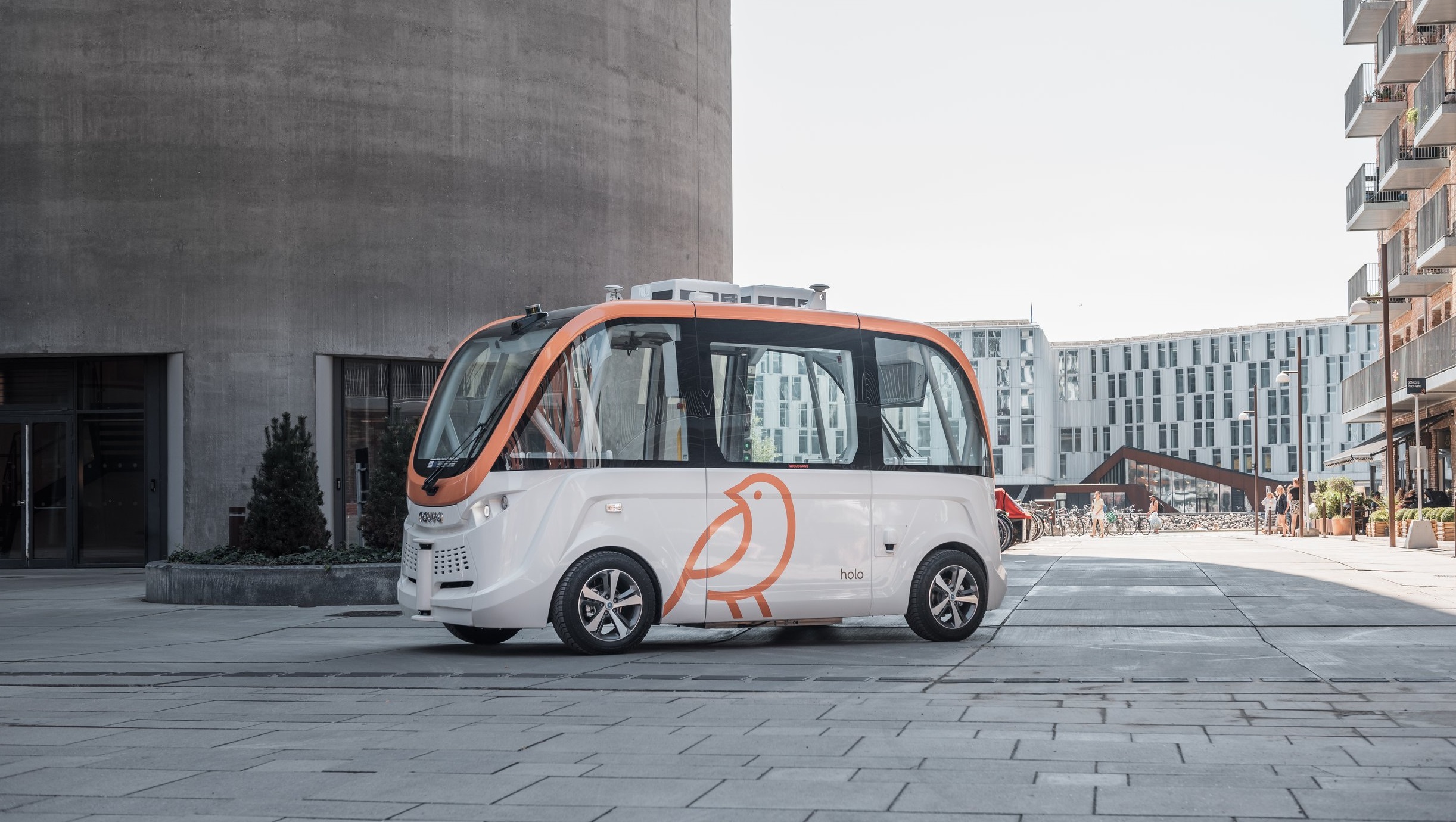AVENUE is an EU-funded project under Horizon 2020 (grant agreement No. 769033). The project started on May 1, 2018 and lasted 48 months (with a 6-month extension).
Avenue’s goal has been to design and carry out full-scale demonstrations of urban transport automation by deploying, for the first time worldwide, fleets of Automated Minibuses (AMs) in low to medium demand areas of 4 European demonstrator cities (Geneva, Lyon, Copenhagen and Luxembourg) and on 2 replicator cities (Uvrier and Esch-sur-Alzette). AVENUE also had the challenging task of revisiting the offered public transportation services, starting from the original problem, which is to allow passengers to move from one place to another. The objective has also been to take into consideration special needs and time constraints, instead of trying to accommodate AMs to the existing solutions of prescheduled bus itineraries.
In this context, AVENUE introduced disruptive public transportation paradigms on the basis of door-to-door services and the nascent concept of ‘Mobility Cloud’, aiming to set up a new model of public transportation. This model enables multimodal public transportation that blends conventional public transport with new service models such as those of the sharing economy and makes use of all possible transportation modes (from bicycles to trains and, of course, AMs).
Public transport services that substantially enhance the passenger experience as well as the overall quality and value of the service have been imagined, also targeting elderly people, those with disabilities and vulnerable users. Road behaviour, security of the AMs and passengers’ safety have also been central points of the AVENUE project.
Mobility models
Public transportation is a key element in the economic development of a region and in the quality of life of its citizens. All around the world, public authorities define strategies for the development of efficient public transports based on different criteria of importance, like the region’s topography, citizen needs and sensibilities, economic barriers, environmental preoccupations, historical development, etc. On the other hand, new technologies, transport modes and services are appearing, which are very promising for the regional public transport development strategies. In Europe, we can identify several strategies that are under development for public transport.
On the one hand, we have what we call the “traditional models”, where one or more public or private organisations provide all public transport in the region using buses or tramways (metro or similar) and where their strategy is to improve the services via the improvement of the buses and tramways.
On the other hand, in many cities, more disruptive models are developed, in which all possible means of transport, ranging from buses and tramways to bicycles and shared ride services, are used under one common model and various services are proposed for its support under what is called “Mobility Cloud”.
In all the mentioned mobility models, it is recognized that the use and integration of autonomous shared vehicles have the potential to drastically improve the services and provide solutions to many of the problems faced today in the development of sustainable and efficient public transport.
AVENUE’s targets
The ultimate goal of the AVENUE project was to demonstrate the suitability and efficiency of the use of small and medium Automated Minibuses (AM) for different transport models that are under development in Europe.
In AVENUE’s vision of the future public transportation in urban and suburban environments, AMs will ensure a safe, rapid, economic, ecological and personalised transport of passengers, minimizing vehicle changes, picking them at their doorstep and depositing them as close as possible to their destination.
To this end, the mission of the project was to demonstrate that AMs will be a key element of the solution for public transport in the future. The project not only aimed to assess the road behaviour and safety of the AMs in public transport, it also aimed to demonstrate the economic, environmental and social advantages of AMs for both the exploiting companies and the users, opening the way for a full-scale adoption of AMs in public transport after the end of the project.
AVENUE integrated, adapted, developed and validated innovative transport vehicle services for passengers, maximising the personalisation and optimization of itineraries, and making travelling a real experience for its passengers.
AVENUE revisited the offered public transport services, starting with the original problem, which is to allow passengers to move from one place to another. Instead of only trying to accommodate autonomous vehicles to the existing solutions of pre-scheduled bus itineraries, AVENUE started by considering the special needs and time constraints of passengers and the different available means of public transport in cities. In this context, AVENUE targeted the creation of disruptive public transport services and aimed to set up a new model of public transport based on on-demand, environmentally friendly, personalised public transport, available anytime, anywhere, and using the most convenient transport means. AVENUE validated different transport models in different European cities, according to their specific transport models and public transport strategies integrating autonomous vehicles and innovative services.
Public transport challenges
Public transport service quality refers to how the service is perceived by the passengers. The commonly used criteria for the definition of public transport service quality are:
- Availability, coverage and accessibility: when and where transit service is available, ease of access to stations
- Service frequency: during the day
- Travel time: (absolute and compared to other means)
- Reliability: observance of the published time schedule
- Integration: transfer ease within the service and with other travel modes
- Pricing, affordability and methods for payment
- Traffic safety
- Passenger security and comfort
- Universality: able to accommodate passengers’ special needs (persons with disabilities, passengers carrying baggage, foreign language speakers)
- Information availability about the service
- Extra services enhancing the passenger’s experience
Public transport operators aim to improve services through an optimal balance between increased and improved service (more vehicles, more kilometers, comfort, convenience, reliability, etc.), usage incentives (lower fares, Parking-and-Rail, etc.) and costs.
Passenger needs
The most common criticisms of public transport concern the low speed and flexibility compared to private cars, the high transport fees and the reliability and availability of the service. In today’s era, where the user empowerment, personalisation and continuous connection to mobile services are becoming the dominant trend, public transport services have very limited options to answer the constantly increasing passenger needs (service personalisation, health issues, handicaps, etc.).
Although different on-line services providing information and trip planning based on the fixed time tables and itineraries are available, they cannot provide the asked service personalisation. Similarly, in-vehicle services are limited to publicity distribution, next bus stops and service disruption announcements. The passengers end up being satisfied by the simple preservation of the existing service quality, since no major improvement can be foreseen.
Autonomous Vehicles – towards a disruption for public transport
Autonomous vehicles will provide the next revolution in urban and suburban transport. The major companies advertise the autonomous cars as the ideal solution for business and family travelling. However, autonomous vehicle transport will have an even higher impact and provide more services when used in the frame of public transportation.
The use of autonomous vehicles for public transport requires the development of new service models that will transform the “simple” ride into a user experience, taking into account the diversity of passenger needs, offering personalised services and covering areas that are not economically accessible today.
Although autonomous public transport vehicles are under pilot testing in many cities around the world, the major barrier for their large-scale adoption is that the transport operators, public authorities and passengers are not yet fully convinced of the safety (road behaviour) of the autonomous vehicles. In consequence, different regulatory restrictions cannot be waived to allow the full exploitation of the autonomous vehicle potential.
Many questions remain unanswered, relating to solid evidence of the vehicle secure operation in today’s complex urban streets, where they will co-exist and share the roads with driver vehicles, pedestrians, bicycles, etc. for many years to come. The large-scale deployment of autonomous vehicles, combined with on-line services, user profiling and dynamic itinerary optimization, will have a snow-ball disruption effect on today’s public transport model.
The drivers’ disappearance will allow transport operators to deploy more vehicles, which will lead to reduction of vehicles’ size, which in turn will allow vehicles to divert from the predefined itineraries and start offering door-to-door services (based on on-line dynamic reservations and optimization). This will lead to transit service personalisation and the introduction of new personalised, user-oriented services, improving the user experience, and in consequence increasing the acceptance and use of public transport services. Furthermore, many cities have started proposing, or considering, alternative means of public transport combining all possible and available transport means, from fleets of autonomous vehicles to public transport, shared ride services, (electric) bicycles, etc., providing the right means and combination of transport for the specific trip. This is known as the Mobility Cloud. The integration of autonomous vehicles will boost the concept and allow a far better approach of public transport in urban and suburban environments.

AVENUE had draw and build upon the accumulated experience from its consortium of 20 partners from 7 European countries, and the operation of Navya’s 200+ minibuses running in 23 countries, in 4 continents, that already demonstrated reliable and safe operation at pilot sites by transporting hundreds of thousands of passengers. The project activities are organised in 11 work packages that have been implemented for 4 years.
Demonstrator Sites
AVENUE has been organised around 4 use cases of autonomous vehicles for public transportation, which represent the “large-scale demonstrators” of the project in Geneva (Switzerland), Lyon (France), Copenhagen (Denmark) and Luxembourg (Luxembourg).


